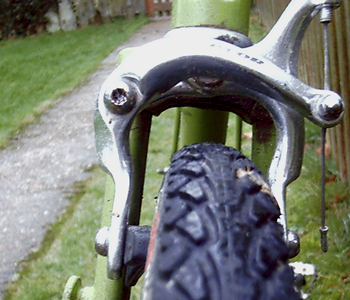[ 63XC.COM | REVIEWS | ALHONGA ]
Alhonga Dual-Pivot Brake
63xc.com attracts equal numbers of mountainbikers and 700c converted-racer types. Neither group claims superiority for their machines. However, if they did, brake setup would be a point in the mountainbikers' favour. Offroad, cantis tend to beat sidepulls. This has to do with mechanical advantage, a slippery engineering concept which I'm not certain I understand. I think it describes the relationship between the movement of the lever and that of the brake. In a caliper mechanism, maximum advantage results when a large movement at the lever maps onto a small one at the brake. But it's difficult to set up a long-reach sidepull for a precise, short travel, especially when fat tyres are involved. For this reason, long-reach sidepull designs tend to offer longer travel and reduced advantage. 700c guys in search of better braking might consider cantilever brazeons, but that's expensive and time-consuming, and may be inappropriate on older frames. A cheaper route is to install one of the sidepull alternatives which came onto the market a generation ago. These were attempts at improving mechanical advantage without modifying the frame. The most familiar is the centrepull, with twin arms pivoting on the ends of a crossbar. But centrepulls are a pig to set up, and--whisper it--don't work that well. Dual-pivots are a better bet. The dual-pivot was pioneered by Altenberger in the 1960s. It resembles a sidepull, with a barrel adjuster and a left arm pivoting about the main bolt. But the right arm pivots on an extension of the left, a modification which makes it easy to bring the shoes in close to the rim, no matter how big the rubber. As a result, the brake offers excellent mechanical advantage, even with fat tyres. By the time Shimano had adapted the Altenberger design for the mass market in the early 90s, cantis and V-brakes were the thing, and most companies in the cloning game didn't bother with the dual-pivot. The Alhonga is pretty much on its own. The design is apparently a straight knockoff of the early Shimanos. Never having seen the originals, I can't comment. But I can say for sure that the brake is a chunky, highly-polished item with Allen bolts at major joints and rather tacky stencilled graphics (may vary between countries). It is neatly made and reassuringly heavy. There is a strong, gnurled cable adjuster, and, best of all, a small Allen bolt near the second pivot which allows you to dial-in the spacing. But how does it work? Well, I've had mine for over a year, and I have no plans to give it up. If you want to pull a two-finger stop on a one-in-five, the Alhonga is a great choice. The 7cm reach works fine with fat tyres and big clearances, and the stopping power is not far short of a canti. The dual-pivot concept has its drawbacks, of course. It lacks subtlety. (Big deal--fixers will be doing the finesse stuff through the back wheel anyway.) And short travel means tight clearances, so the brake won't work with even a mild taco. You need to be fairly sure of your wheels. These are generic faults of the type--if you can't live with 'em, don't buy a dual-pivot. The Alhonga also has a couple of particular quirks. It lacks any QR mechanism, so there's no way to mount a fat tyre unless it's deflated. And the Allen key bolts appear to be chromed steel. They start to rust after a few months in the wet. You'll forgive these oversights when you see the price. In the UK, you can buy an Alhonga for fifteen quid. In the US, it will cost $20. That's a little more than one third the price of an Ultegra, and the Alhonga has longer reach. All in all, the Alhonga is a cheap classic. If you're doing up an old tourer as a budget offroader, you really can't do better. Quality
[ TOP ] |
Writer
Will Meister now rides mostly fixed. He is planning a special bike for the unique trails of the South Downs.
Date
v1.0 written December 2002
Suppliers
European readers can source Alhonga stuff through SJS Cycles. Non-euros take note: no-one at Alhonga replied to our emails, and their site is given over to flash new disk brakes. If your LBS can't help you, try ordering through SJS Cycles. The airmail shouldn't be more than 4 or 5 bucks.
Mailing list
Join the 63xc.com list.
